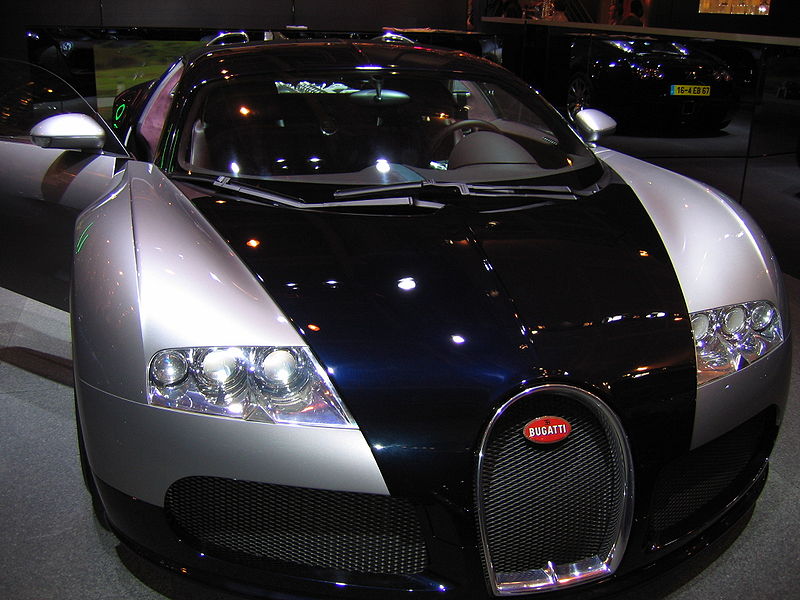
One quickly runs out of superlatives when trying to describe the Bugatti Veyron. I'm not even sure if one should use the word "car" to refer to such a monster. Endowed with absolute power and a daunting maximum speed, the Veyron looks and sounds like it just came out of some impossible future inhabited by gigantic gas pumps.

50 years after Ettore Bugatti's death, Volkswagen used its magic wand to resurrect the legendary firm, and to say the least, the German carmaker did a mindblowing job.

Motorsports enthusiasts will instantly refer you to the mythical Bugatti Royale from the 1930s, a colossal and majestic masterpiece, sold at such a prohibitive price that only three people were able to afford to buy it at the time. The Royale turned out to be one of the most rare and prestigious automobiles of all times, but despite record-breaking performances, its endless and fairytale-like silhouette became above all a symbol of unequivocable luxury able to make any Rolls Royce look like your everyday sedan. Instead of trying to match the Royale's incredible legacy, re-Volkswagen decided to look for inspiration in Bugatti's racing history to design the Veyron, rightfully using the name of the famous driver who won at Le Mans in 1939 behind the wheel of a Bugatti Type 57.

We got to drive this exceptional vehicle for a few miles in the parking lot of a San Diego country club. It's easy to feel intimidated by this incredible machine, so we carefully and promptly handed it back to its official tutor, French race car driver PierHenri Raphanel.

The Veyron is unbeatable. Its wide and massive shape sets it aside from other supercars such as the sleek Mercedes McLaren SLR or the angular Ferrari Enzo. But the real thrill comes from the Veyron's unrivaled performances: with an engine delivering 1001 hp and a top speed neighboring 250 mph, the new Bugatti flies over the road like a rocket in the morning sky. The Veyron goes from 0 to 62 mph in 2.5 seconds, which is no less than a second faster than a Ferrari Enzo. Pedal to the metal, you can reach 200 mph in little more than 15 seconds. This is a first in the field of street-legal vehicles, and you would have to steal a Champ Car to have a chance to catch up with the Veyron. To be frank, at the end of the day, I still wouldn't put a dollar on you.

Revolutionary techniques were involved in the making of this 21st Bugatti. In order to gather the 1001 horsepower needed to establish a new automotive legend, Volkswagen has designed an 8 liter W16 engine by mating two narrow-angle V8s. Peak torque is 922 lb/ft at 2200 rpm No less than four turbochargers garnish this frenzied powerhouse and engineers had to come up with a special seven-speed dual-clutch transmission to allow for all this wild energy to be transferred to the road. Needless to say, fuel efficiency was never an issue in the process, and you'll be delighted to learn that the Bugatti Veyron has given a new meaning to the term gas-guzzler by settling for a little more than 2 miles per gallon at top speed. In this configuration, the tank would go from full to empty in less than 12 minutes. All kinds of rumors are surrounding this unbelievable ride: pushing hard on this monster will make a set of tires last about 125 miles.

It took several years of trial and error to achieve the Bugatti Veyron's final version. Launched by flamboyant CEO Ferdinand Piëch in 1999, the project started with a prototype equipped with a W18 engine (three flatV6's side by side).

Soon, engineers realized they needed a more compact structure, and the W16 was adopted and installed in a mid-rear position. Fine tuning the beast was a long and difficult task, and many incidents occurred during the testing. A lack of stability at high speed even provoked an accident and the destruction of a prototype. In 2003, Piëch was replaced by Bernd Pischetsrieder at the helm of Volkswagen, and the new leadership took the project back to the drawing board. Under the supervision of engineer Wolfgang Shreiber, the Veyron became more stable and drivable. Gordon Murray, the famous and brilliant father of the astounding McLaren F1 of the early 90s who had in the past harshly criticized the Veyron initial concept and prototypes, was recently revealing his thoughts on the Bugatti's final version: "One really good thing, and I simply never expected this, is that it does change direction. It hardly feels its weight. Driving it on a circuit I expected a sack of cement, but you can really throw it at tight chicanes."

Only 300 Bugatti Veyrons will be made over the next five years. It will cost you no less than $1.5 million to get your hands on one of them, but apparently, Bugatti has already received 70 firm orders. In a classy move, Volkswagen moved Bugatti back to Ettore's original headquarters at Saint Jean Castle in Molsheim, Alsace, and the resurrected firm should even increase its production in 2006 to meet the demand. Believe it or not, all in all, the Veyron is a good bargain: its manufacturing costs far exceed its selling price. Following the steps of its respectable ancestors, this unique automobile is first and foremost a magnificent and decadent study announcing the end of an era. Stepping away from the cockpit of this unforgettable machine, lost in a state of denial, it was almost hard to keep in mind that the days of gasoline engines are numbered.






.jpg)



















































